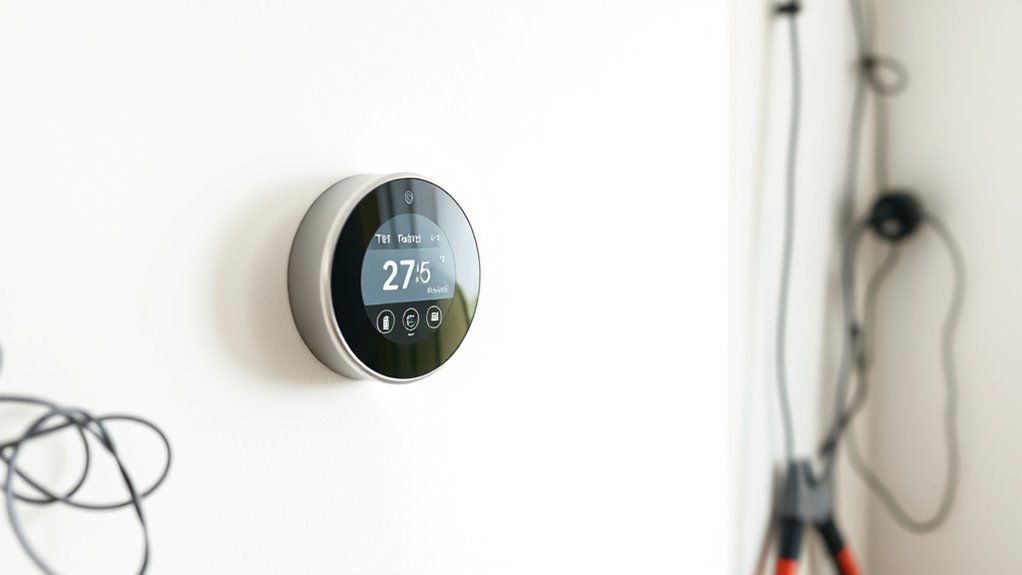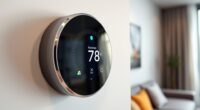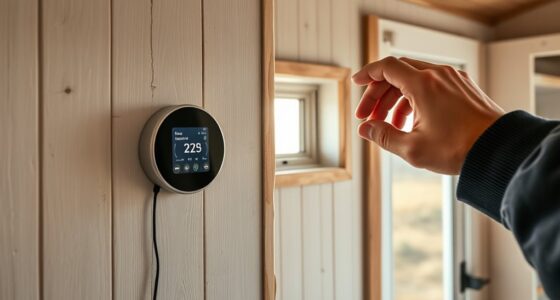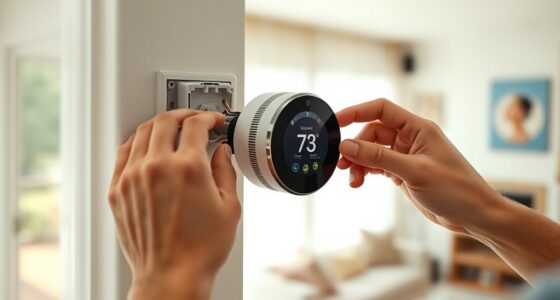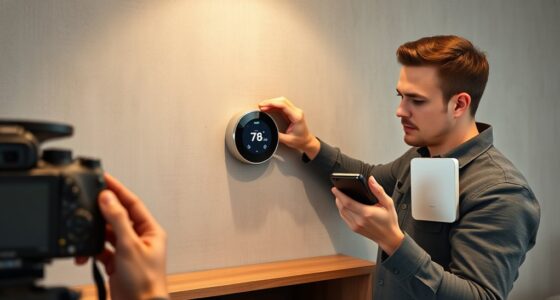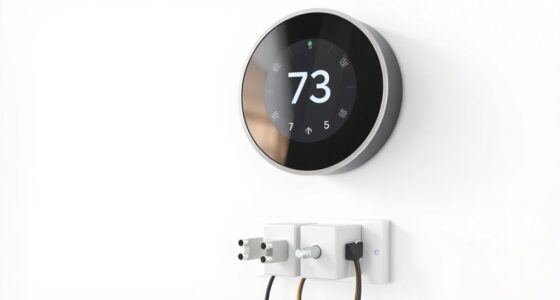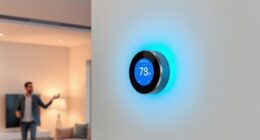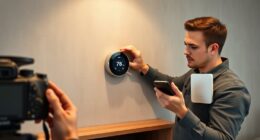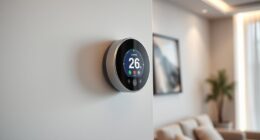To avoid common smart thermostat installation mistakes, start by ensuring your Wi-Fi signal is strong and compatible with your network, and double-check that your system works with your HVAC setup. Turn off power before wiring, follow the manufacturer’s instructions carefully, and avoid rushing through setup steps. Planning for potential issues and troubleshooting beforehand can save time and frustration. Keep these tips in mind, and you’ll be on your way to a smooth installation—more insights await if you keep exploring.
Key Takeaways
- Verify Wi-Fi compatibility and signal strength to prevent connectivity issues during setup.
- Confirm thermostat compatibility with your HVAC system to avoid malfunctions or damage.
- Turn off power before wiring and follow manufacturer diagrams carefully to ensure proper connections.
- Plan installation steps thoroughly and troubleshoot potential problems in advance.
- Follow all setup instructions precisely, including firmware updates and personalized settings.
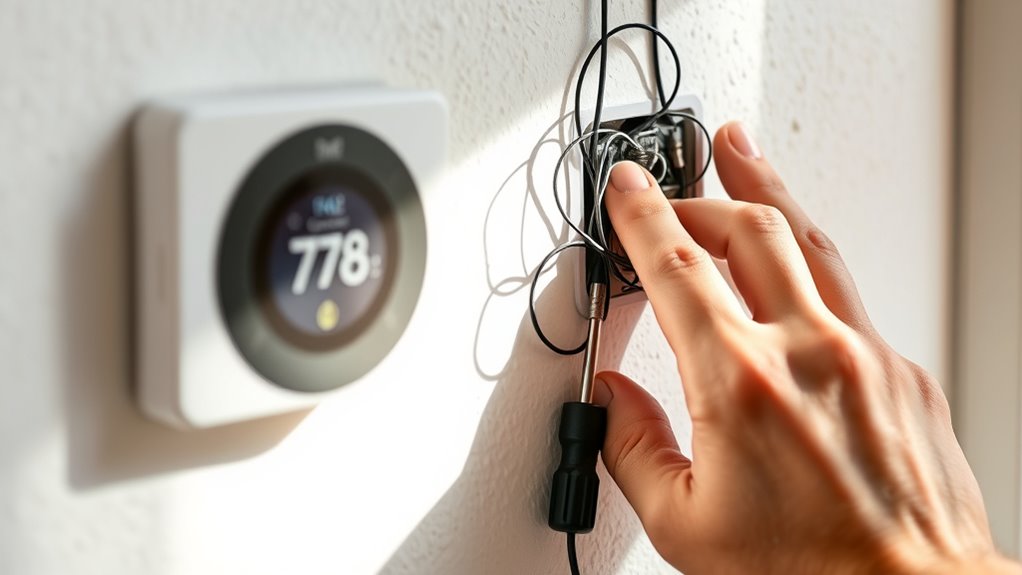
Installing a smart thermostat can substantially improve your home’s comfort and energy efficiency, but rushing the process or skipping key steps can lead to costly mistakes. One of the most common errors homeowners make involves overlooking wireless connectivity requirements. Before you install, confirm your thermostat’s Wi-Fi capabilities are compatible with your home network. Weak or unstable wireless signals can cause disconnections or slow updates, hindering your ability to control the device remotely or access advanced features. To avoid this, verify your router’s range and consider relocating it or adding a Wi-Fi extender if needed. Also, check if your thermostat supports dual-band Wi-Fi (2.4 GHz and 5 GHz), as some models only work with specific frequency bands. Failing to verify these details can result in setup frustrations and ongoing connectivity problems, defeating the purpose of a smart device.
Another critical mistake involves ignoring compatibility issues. Not all smart thermostats work seamlessly with every HVAC system, so it’s crucial to verify compatibility before purchasing. Some thermostats are designed for specific systems like heat pumps, multi-stage heating, or certain wiring configurations. If you install a model incompatible with your system, you might face issues like inaccurate temperature readings, system malfunctions, or even damage to your HVAC components. Take the time to review your system’s specifications and consult manufacturer compatibility charts or seek professional advice if you’re unsure. Properly matching your thermostat to your HVAC system ensures smooth operation and reduces the risk of costly repairs down the line.
Additionally, many homeowners neglect to double-check the wiring connections during installation. Even if the thermostat appears to fit your existing wiring, a mismatch or loose connection can cause operational glitches. Turn off the power before handling wires and carefully follow the wiring diagram provided by the manufacturer. If you’re uncertain about which wires connect where, consulting your system’s manual or hiring a professional can save you from potential damage or malfunctions. Proper wiring ensures your thermostat communicates correctly with your HVAC system and functions reliably over time. Checking wiring compatibility thoroughly can prevent common setup errors and improve overall performance.
Furthermore, neglecting to consider the importance of creative problem-solving during installation can lead to overlooked issues or suboptimal setups. Taking a methodical, thoughtful approach helps identify potential challenges early and find effective solutions, ensuring your system works efficiently. In addition, having a clear understanding of your home’s specific wiring and network setup can help you troubleshoot any issues that arise during installation more effectively.
Finally, resist the temptation to rush through setup or skip reading the instructions. Proper installation and configuration are crucial for peak performance. Take your time to follow each step carefully, update the firmware if necessary, and customize settings to match your preferences. Doing so minimizes errors and maximizes the benefits of your smart thermostat. Remember, a thoughtful, deliberate approach during installation can prevent frustrations, reduce troubleshooting later, and ensure your smart thermostat delivers on its promise to enhance your home’s comfort and energy savings.
Frequently Asked Questions
Can I Install a Smart Thermostat Myself Without Professional Help?
You can attempt DIY installation of a smart thermostat if you have some technical expertise and are comfortable working with wiring. However, if you’re unsure about your skills or the wiring setup, it’s best to seek professional help. Proper installation guarantees your smart thermostat functions correctly and safely. Rushing into DIY without proper knowledge might lead to mistakes, so evaluate your comfort level before proceeding.
Which Smart Thermostats Are Compatible With My Existing HVAC System?
When choosing a smart thermostat, you should check its compatibility with your HVAC system using a compatibility checklist. First, review your system’s wiring requirements to guarantee the thermostat is compatible. Look for models that support your current wiring type, whether it’s C-wire or not. This way, you avoid installation issues and ensure your smart thermostat functions smoothly with your existing HVAC setup.
How Do I Troubleshoot Connectivity Issues After Installation?
Ever feel like your smart thermostat is playing hide and seek? First, check your Wi-Fi signal strength—weak signals cause connectivity hiccups. Next, review your router placement; keep it central and away from interference. Restart your thermostat and router to refresh connections. If issues persist, update your firmware or reset the device. Remember, a strong Wi-Fi signal and strategic router placement are key to seamless smart thermostat performance.
What Are the Best Practices for Securing My Smart Thermostat From Hacking?
To keep your smart thermostat secure from hacking, focus on strengthening your home network security by updating your router firmware regularly and enabling WPA3 encryption. Use strong, unique passwords for your thermostat and Wi-Fi, and avoid default credentials. Practice good password management by changing passwords periodically and using a password manager. These steps help protect your device and your entire home network from potential cyber threats.
How Often Should I Update the Firmware of My Smart Thermostat?
You should update your smart thermostat’s firmware regularly, ideally whenever updates are available. Firmware updates are vital for security, performance, and new features. Incorporate these updates into your maintenance schedules to guarantee your device stays protected and efficient. Don’t wait too long—delaying updates can leave your thermostat vulnerable. Checking for firmware updates at least once a month is a good habit, keeping your smart thermostat running smoothly and securely.
Conclusion
By steering clear of these common installation pitfalls, you transform your home into a sanctuary of comfort and efficiency. Imagine your smart thermostat as a conductor guiding the symphony of your living space, each note perfectly tuned. When installed correctly, it seamlessly adapts to your lifestyle, saving energy and lowering bills. Embrace this mindful approach, and watch your home become a harmonious haven—where innovation and comfort dance together effortlessly beneath your fingertips.
